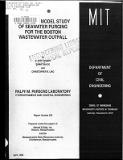Hydraulic Model Study of Seawater Purging for the Boston Wastewater Outfall
Author(s)
Adams, E. Eric; Sahoo, Dipak; Liro, Christopher R.
Download21668371.pdf (4.357Mb)
Metadata
Show full item recordAbstract
A 1:83 hydraulic scale model was built to study the mechanism of seawater purging in the tunneled outfall that will convey effluent from MWRA's Secondary Treatment Plant on Deer Is. out into Massachusetts Bay. Purging generally requires high rates of effluent flow which presents a concern for the Boston system because of the wide range of expected flow rates. Daily average flow rates are expected to range from about 320 mgd to 1270 mgd although instantaneous rates as low as 150 mgd may occur. Model results for the original outfall design (described in the Secondary Treatment Facilities Plan) showed that riser purging would require an effluent flow rate of over 900 mgd, which is slightly less than the theoretical (Munro) criterion. Furthermore, because of the increase in tunnel invert slope beginning at the riser section, tunnel purging would require an effluent flow rate of over 800 mgd. Hence there would be significant periods of time when the effluent flow rate would be insufficient to purge seawater from either the tunnel or the riser sections of the outfall. The resulting unpurged condition would lead to poor distribution of the effluent within the receiving water and possible problems with sediment accumulation and biofouling within the tunnel. However, once purged the outfall would not experience seawater intrusion until flows dropped below the expected low-flow condition. Construction of a tunnel constriction (Venturi section) just upstream from the risers was found to substantially reduce seawater penetration in the tunnel by creating a condition of densimetric critical flow. Theoretical calculations for a section with a 10' throat suggested that penetration could be eliminated for flows greater than about 420 mgd while observations showed elimination for flows greater than about 340 mgd. The lower observed flow is attributed to downstream mixing. The effluent flow rate required for riser purging would remain essentially the same--about 900 mgd. Further tests showed that, in combination with the Venturi section, a short-term increase in effluent flow caused by intermittent dumping of the chlorine-contact tanks would significantly reduce the purging requirement. The release could be made through motorized gates and would require a peak flow of at least 700 mgd over a duration of 10 to 20 minutes. The total excess flow volume would be about 600,000 ft3, which is about one-third of the total volume and about one-half of the active volume of the chlorine-contact tanks. Because of the absence of seawater penetration upstream of the Venturi, this "rapid-purge" procedure would be successful at base flows down to 340 mgd or less, substantially increasing the periods of time when purging is possible.
Description
Sponsored by Metcalf and Eddy, Inc., Wakefield, Mass. OSP 72065. Sponsored by the Massachusetts Water Resources Authority, Boston, Mass.
Date issued
1990-04Publisher
Cambridge, Mass. : Ralph M. Parsons Laboratory, Hydrodynamics and Coastal Engineering, MIT, Dept. of Civil Engineering
Other identifiers
329
Series/Report no.
R (Massachusetts Institute of Technology. Department of Civil Engineering) ; 90-05.Report (Ralph M. Parsons Laboratory for Water Resources and Hydrodynamics) ; 329.